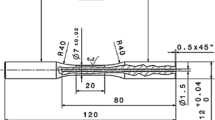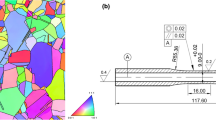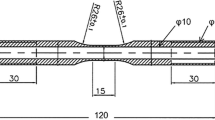Abstract
Strain controlled low cycle fatigue tests have been conducted in air to ascertain the influence of strain rate(ε = 4 × 10-6'to 4 × 10-3 s-1) and temperature(T = 750/850/950 °C) on LCF behavior of Alloy 617. A strain range of 0.6 pct and a symmetrical triangular wave form were employed for all the tests. Crack initiation and propagation modes were studied. Microstructural changes that occurred during fatigue deformation were evaluated and compared with the results obtained on isothermal aging. Deformation and damage mechanisms which influence the endurance have been identified. A reduction in fatigue life was observed with decreasing ε at 850 °C and with increasing temperature at ε = 4 × 10-5 s-1. Cyclic stress response varied as a complex function of temperature and strain rate. Fatigue deformation was found to induce cellular precipitation of carbides at 750 and 850 ‡. Dynamic strain aging characterized by serrated flow was observed at 750 °C (ε = 4 × 10-5 s-1) and in the tests at higher ε at 850 °C. Strengthening of the matrix due to dynamic strain aging of matrix dislocations by precipitation of M23C6 carbides led to fracture of grain boundary carbide films formed at 750 °C, producing brittle intergranular crack propagation. At 850 °C transgranular crack propagation was observed at the higher strain rates ε≥4× 10-4 s-1. At 850 and 950 °C even at strain rates of 4 × 10-5 s-1 or lower, life was not governed by intergranular creep rupture damage mechanisms under the symmetrical, continuous cycling conditions employed. Reduction of endurance at lower strain rates is caused by increased inelastic strain and intergranular crack initiation due to oxidation of surface connected grain boundaries.
Similar content being viewed by others
References
J.C. Hosier and D. J. Tillack:Met. Eng. Quart., 1972, vol. 12, pp. 51–55. LURGICAL TRANSACTIONS A
J.P. Strizak, C. R. Brinkman, and E. L. Rittenhouse: Specialists Meeting on High Temperature Metallic Materials for Application in Gas Cooled Reactors, IAEA Report No. 158.434, May 1981, pp. T1-T15.
H. P. Meurer, H. Breitling, and E. D. Grosser: Proc. Conf. Behaviour of High Temperature Alloys in Aggressive Environments, Petten, 1979, The Metals Society, 1980.
H. P. Meurer, G. K. H. Gnirss, W. Mergler, G. Raule, H. Schuster, and G. Ullrich:Nuclear Technology, 1984, vol. 66, pp. 315–23.
ASTM Designation E 606-80, 1980, Part 10, pp. 694-713.
R.E. Reed-Hill:Rev. High Temp. Mat., 1974, vol. 2, pp. 217–42.
A. Pineau:Fatigue at High Temperatures, R. P. Skelton, ed., Applied Science Publishers, London, 1983, pp. 305–64.
C. H. Wells:Acta Metall., 1969, vol. 17, pp. 443–49.
M. Gell and G. R. Levarent: ASTM STP 520, 1973, pp. 37-67.
M. Clavel, C. Levaillant, and A. Pinneau:Creep-Fatigue- Environment Interactions, R. M. Pelloux and N. S. Stoloff, eds., TMS-AIME, Warrendale, PA, 1980, pp. 24–45.
R. F. Decker and C. T. Sims: inThe Superalloys, C. T. Sims and W. C. Hagel, eds., Wiles, New York, NY, 1974, 9.33.
H. I. Dawson:J. Appl. Physics, 1968, vol. 39, pp. 3022–25.
H. M. Rosenberg:Vacancies and Other Point Defects in Metals and Alloys, Institute of Metals, London, 1958, p. 206.
E.W. Johnson and H.H. Johnson:Trans. AIME, 1965, vol. 233, pp. 1332–40.
H. Kirchhöfer, J. Rottmann, F. Schubert, and H. Nickel: KFA Report ISSN 0366-0885, March 1984.
S. Khihara, J.B. Newkirk, A. Ohotomo, and Y. Saiga:Metall. Trans. A, 1980, vol. 11A, pp. 1019–31.
T. Takahasi, J. Fujiwara, T. Matsushima, M. Kiyckawa, I. Morimoto, and T. Watanabe:Trans. Iron Steel Inst. Japan, 1978, vol. 18, pp. 221–24.
W. L. Mankins, J.C. Hosier, and T. H. Bassford:Metall. Trans., 1974, vol. 5, pp. 2579–90.
M.A. Burke and C.G. Beck:Metall. Trans. A, 1984, vol. 15A, pp. 661–70.
D. B. Williams and E. P. Butler:Intl. Met. Reviews, 1981, vol. 26, pp. 153–83.
P.S. Kotval and H. Hatwell:Trans.AIME, 1969, vol. 245, pp. 1821–24.
E. L. Raymond:Corrosion, 1968, vol. 24, pp. 180–88.
H.F. Merrick, H.W. Hayden, and R.C. Gibson:Metall. Trans., 1973, vol. 4, pp. 827–32.
K. Bhanu Sankara Rao, M. Valsan, R. Sandhya, S. L. Mannan, and P. Rodriguez:High Temperature Materials and Processes, 1986, vol. 7, no. 1, in press.
M. E. Abdel-Azim, P. J. Ennis, and H. Schuster: Institute of Reactor Materials, Nuclear Research Centre, Jiilich, GmbH, unpublished research, 1985.
O. F. Kimball, G. Y Lai, and G. H. Reynolds:Metall. Trans. A, 1976, vol. 7A, pp. 1951–52.
J. Wareing:Fatigue at High Temperature, R. P. Skelton, ed., Applied Science Publishers, London, 1983, pp. 135–85.
D. Sidey and L. F. Coffin, Jr.: ASTM STP 675, 1979, pp. 528-68.
B. K. Min and R. Raj: ASTM STP 675, 1979, pp. 569-91.
B. Kempf, K. Bothe, and V. Gerold: Proc. of the ECF 6 Amsterdam/NL, June 1986, inFracture Control of Engineering Structures, H.C. van Elst and A. Bakker, eds., EMAS, Adv. Serv. Ltd., Warley W. M./U.K., vol. II, pp. 1129–38.
K. Bhanu Sankara Rao, H. Schiffers, and H. Schuster: Nuclear Research Center, Juelich, GmbH, D-5170 Juelich, 1986, in press.
J. Bressers and M. Roth: ASME Int. Conf. on Advances in Life Prediction Methods, D. A. Woodford and J.R. Whitehead, eds., 1983, pp. 85-92.
S. Bashir and S. D. Antovolich:Superalloys 1984,TMS-AIME, 1984, pp. 295-307.
B.A. Lerch: NASA Lewis Research Center Report 165 497, 1982.
S.D. Antovolich, P. Domas, and J.L. Strudel:Metall. Trans. A, 1979, vol. 10A, pp. 1859–68.
L. F. Coffin, Jr.:Metall. Trans., 1974, vol. 5, pp. 1053–60.
L. F. Coffin, Jr.:Corrosion Fatigue, Nat. Ass. Corr. Eng., Houston, TX, 1972, pp. 590–600.
L. F Coffin, Jr.:Trans. ASM, 1963, vol. 56, pp. 339–44.
J. Wareing, H.G. Vaughan, and B. Tomkins: Creep-Fatigue- Environments Interactions, Proc. TMS-AIME Symp. Fall Meeting, Milwaukee, WI, R. M. Pellow and N. Stoloff, eds., 1980, p. 129.
K. Bhanu Sankara Rao, H. P. Meurer, and H. Schuster: Nuclear Re- search Centre, Jiilich, GmbH, D-5170 Juelich and Interatom, GmbH, D-5060 Bensberg, unpublished research, 1986. $
Author information
Authors and Affiliations
Additional information
formerly Guest Scientist at the De-partment for Reactor Materials of the Nuclear Research Centre, Juelich (IRW/KFA),
Rights and permissions
About this article
Cite this article
Rao, K.B.S., Schiffers, H., Schuster, H. et al. Influence of time and temperature dependent processes on strain controlled low cycle fatigue behavior of alloy 617. Metall Trans A 19, 359–371 (1988). https://doi.org/10.1007/BF02652546
Received:
Issue Date:
DOI: https://doi.org/10.1007/BF02652546




